![]() | Sam Auto Group | About | 4x4 Vehicles | Accessories |
Executives |
Testimonials |
Mission | Links | Contact |
| Sam Auto Group | About | 4x4 Vehicles | Accessories |
Executives |
Testimonials |
Mission | Links | Contact |
![]()
Toyota Hilux Vigo | Mitsubishi L200 Triton | Nissan Navara | Toyota Fortuner | DMax | Chevy Colorado | Ford Ranger
![]() | Sam Auto Group | About | 4x4 Vehicles | Accessories |
Executives |
Testimonials |
Mission | Links | Contact |
| Sam Auto Group | About | 4x4 Vehicles | Accessories |
Executives |
Testimonials |
Mission | Links | Contact |
![]()
Toyota Hilux Vigo | Mitsubishi L200 Triton | Nissan Navara | Toyota Fortuner | DMax | Chevy Colorado | Ford Ranger
Thailand 4x4 pickup SUV exporter importer of RHD LHD New 2017 and Used Toyota Revo, Toyota Vigo, Toyota Fortuner, L200 Triton, and Nissan Navara
A tire is made up of several different components.
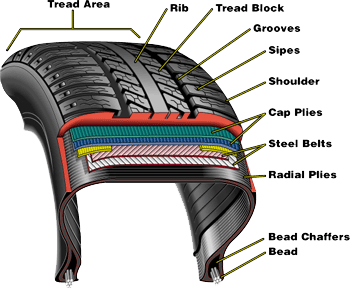 The Tread is made from a mixture of
many different kinds of natural and synthetic
rubbers. The tire tread provides the gripping
action and traction that prevent your vehicle
from slipping or sliding, especially when the
road is wet or icy.
The Tread is made from a mixture of
many different kinds of natural and synthetic
rubbers. The tire tread provides the gripping
action and traction that prevent your vehicle
from slipping or sliding, especially when the
road is wet or icy.
The tread is that portion of the tire that comes in contact with the road. The tread is a thick rubber compound formulated to provide a high level of traction that does not wear away too quickly. The tread pattern is characterized by the geometrical shape of the grooves, lugs, and voids. Grooves run circumferentially around the tire, and are needed to channel away water. Lugs are that portion of the tread design that contacts the road surface. Voids are spaces between lugs that allow the lugs to flex. Tread patterns feature non-symmetrical lug sizes circumferentially in order to minimize noise.
Treads are often designed to meet specific product marketing positions. High performance tires have small void ratios to provide more rubber in contact with the road for higher traction, but may be compounded with softer rubber that provides better traction, but wears quickly. Mud and snow tires are designed with higher void ratios to channel away rain and mud, while providing better gripping performance. When installing two new tires with a deep tread, they should be placed in the rear to minimize the chance of oversteer.
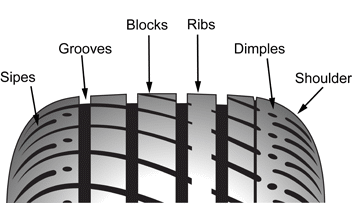 Tread
is a lot more than the rubber blocks around the
outside of your tire . The proper choice of tread design for
a specific application can mean the difference
between a comfortable, quiet ride, and a poor excuse for a tire that leaves you feeling
exhausted whenever you get out of your car.
Tread
is a lot more than the rubber blocks around the
outside of your tire . The proper choice of tread design for
a specific application can mean the difference
between a comfortable, quiet ride, and a poor excuse for a tire that leaves you feeling
exhausted whenever you get out of your car.
A proper tread design improves traction,
improves handling and increases Durability. It
also has a direct effect on ride comfort, noise
level and fuel efficiency. Believe it or not,
each part of the tread of your tire has a
different name, and a different function and
effect on the overall tire. Your tires might not
have all these features, but the diagram on the
left gives a rundown of
what they look like, what they're called and why
the tire manufacturers spend millions each year
fiddling with all this stuff.
Sipes are the small,
slit-like grooves in the tread blocks that allow
the blocks to flex. This added flexibility
increases traction by creating an additional
biting edge. Sipes are especially helpful on
ice, light snow and loose dirt.
Grooves create voids for better water
channeling on wet road surfaces (like the
Aquachannel tires below). Grooves are the most
efficient way of channeling water from in front
of the tires to behind it. By designing grooves
circumferentially, water has less distance to be
channeled.
Blocks are the segments that make up the
majority of a tire's tread. Their primary
function is to provide traction.
Ribs are the straight-lined row of blocks
that create a circumferential contact "band."
Dimples are the indentations in the
tread, normally towards the outer edge of the
tire. They improve cooling.
Shoulders provide continuous contact with
the road while maneuvering. The shoulders wrap
slightly over the inner and outer sidewall of a
tire.
The Void Ratio is the amount of open
space in the tread. A low void ratio means a
tire has more rubber is in contact with the
road. A high void ratio increases the ability to
drain water. Sports, dry-weather and high
performance tires have a low void ratio for grip
and traction. Wet-weather and snow tires have
high void ratios.
Tread lugs provide the contact surface necessary to provide traction. As the tread lug enters the road contact area, or footprint, it is compressed. As it rotates through the footprint it is deformed circumferentially. As it exits the footprint it recovers to its original shape. During the deformation and recovery cycle the tire exerts variable forces into the vehicle. These forces are described as Force Variation.
Tread voids provide space for the lug to flex and deform as it enters and exits the footprint. Voids also provide channels for rain water to flow out of the footprint. Voids also provide space for mud and snow to be channeled away from the footprint. The void ratio is the void area of the tire divided by the entire tread area. Low void areas have high contact area and therefore higher traction.
The rain groove is a design element of the tread pattern specifically arranged to channel water away from the footprint. Rain grooves are circumferential in most truck tires. Many high performance passenger tires feature rain grooves that are angled from the center toward the sides of the tire. Some tire manufacturers claim that their tread pattern is designed to actively pump water out from under the tire by the action of the tread flexing
Tread lugs often feature small narrow voids, or sipes, that improve the flexibility of the lug to deform as it traverses the footprint area. This reduces shear stress in the lug and reduces heat build up
In general, tires are not safe and should be replaced when the tread is worn down to 1/16 of an inch. One easy method for checking tread depth is to place a coin in the tread with portrait's head upside down and facing you. If you can see the best of head, you are ready for new tires. The tire tread is made up of the rib, tread block, grooves, sipes and shoulder.
The sidewall provides lateral stability for the tire, protects the body plies and helps keep the air from escaping. Sidewalls also contain additional components to help increase the lateral stability of the tire.
The sidewall is that part of the tire that bridges between the tread and bead. The sidewall is reinforced with rubber and fabric plies that provide for strength and flexibility. The sidewall transmits the torque applied by the drive axle to the tread in order to create traction. Sidewalls are molded with decorative ornamentation, government mandated warning labels, and other consumer information.
Over time, rubber degrades. Ford has recommended that tires be replaced when they are 6 years old to prevent sudden failure, even if the tire looks undamaged. In tropical climates, such as in Thailand, tires degrade sooner than in temperate climates, such as the United States.
Cap Plies are an extra layer or two of polyester fabric to help hold everything in place. These cap plies are not found on all car and truck tires. They are mostly used on tires with higher speed ratings to help all the components stay in place at high speeds.
Steel Belted radial tires have belts made from steel that are used to reinforce the area under the tread. These belts provide puncture resistance and help your car tire stay flat so that it makes the best contact with the road.
Radial Plies is made up of several layers of different fabrics. The most common ply fabric is polyester cord. The cords in a radial tire run perpendicular to the tread. Some older tires used diagonal bias tires, tires in which the fabric ran at an angle to the tread. The plies are coated with rubber to help them bond with the other components and to seal in the air.
Bead Bundle or Bead Chaffers and Bead is a loop of high-strength steel cable coated with rubber. It gives the tire the strength it needs to stay seated on the wheel rim and to handle the forces applied by tire mounting machines when the tires are installed on rims.
Tire manufacturing is a complex process, starting with the raw materials which pass through several processes to arrive at the finished tire. Rubber is the best known material in tires. The term rubber describes the physical properties of the material, rather than its chemical composition.
All of the above components are assembled in a tire making machine. This machine ensures that all of the components are in the correct location and then forms the tire into a shape and size fairly close to its finished dimensions.
After the tire has all of its components, it's not held together very tightly, and it doesn't have any markings or tread patterns. The next step in the assembly is to run the tire into a curing machine, which functions something like a waffle iron, molding in all of the markings and traction patterns. The heat bonds all of the tire's components together. This process is called vulcanizing. Auto Tire Ratings.
Siping is a process of cutting thin slits across a rubber surface to improve traction in wet or icy conditions.
Siping was invented and patented by John Sipe in the 1920s. Sipe worked in a slaughterhouse and grew tired of slipping on the wet floors. He found that cutting slits in the tread on the bottoms of his shoes provided better traction than the uncut tread.
The process was not applied to vehicle tires on a large scale until the 1950s, when superior tread compounds were developed that could stand up to the siping process. On roads covered with snow, ice, mud, and water, sipes usually increase traction. A US patent to Goodyear claimed sipes improve tire traction as well, and tend to close completely in the tire "footprint" on the road. A 1978 study by the US National Safety Council found siping improved stopping distances by 22 percent, breakaway traction by 65 percent, and rolling traction by 28 percent on glare ice.
Tire tread block shapes, groove configurations, and sipes affect tire noise pattern and traction characteristics. Typically, wide, straight grooves have a low noise level and good water removal. More lateral grooves usually increase traction. Sipes are small grooves that are cut across larger tread elements. Up to a point, more sipes give more traction in snow or mud.
As is often the case, there are compromises. Winter tires, and "mud and snow" tires, may have thousands of sipes and give good traction. But, they may feel "squirmy" on a warm, dry road. Treadless racing "slicks" on dry roads give maximum traction. These have no sipes, no grooves, and no tread blocks. They also have very poor traction on wet surfaces. Tire manufacturers use different tread rubber compounds and tread designs for different tires' usages.
Large sipes are usually built into the tread during manufacturing. Sipes may also be cut into the tread at a later date, called "microsiping". Bandag developed a machine for microsiping which places a curved knife blade at a slight angle on a rotating drum. The drum is placed so when it is pressed against the tread the tire is pressed into an exaggerated hollow, as if driving down a rail. The drum is lubricated and rotated and the knife makes a series of diagonal cuts across the tread. For improved traction, the tire may be siped twice, leaving diamond-shaped blocks. A significant problem with field siping is that the tread picks up rocks, glass, and other hard road debris in use, and even with thorough cleaning the knife service life is often poor.
Microsiping can dramatically improve tire traction in rain and snow. However, microsiped tires may also have increased road noise and tire wear when operated on dry surfaces.
Tire siping is the process of cutting small slits, or grooves, into the tread blocks of tires in order to provide better traction in adverse weather conditions. The sipes allow the tread blocks to spread on contact with the ground, which helps expel water from the tread and provides better bite. Practically every all-season, mud+snow, and all terrain tire marketed today is siped in the factory mold, yet few mud terrain tires are siped. The traction benefits of siping, along with the purported increase in tire life due to improved heat dissipation from siped lugs, is something that can easily (and quickly) be done at home if you know how to do it right, we of course assume no warranty if you choose to do so. The simplest way to sipe tires is to take them to a local tire shop and have them cut. However, many of the siping machines used at shops do not account for all tread designs, may cut the tread blocks close to the leading or trailing edges of the tread blocks (causing the lugs to chunk easily), or don't allow for anything other than cuts straight across the tread block.
Simply put, if you bought a car in the last 20 years or so, you should be riding on radial tires. If you're not, then it's a small miracle you're still alive to be reading this. Radial tires wear much better and have a far greater rigidity for when cars are cornering and the tires are deforming.
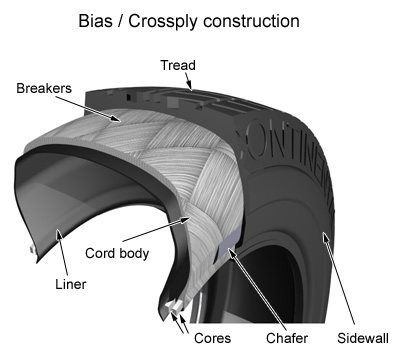
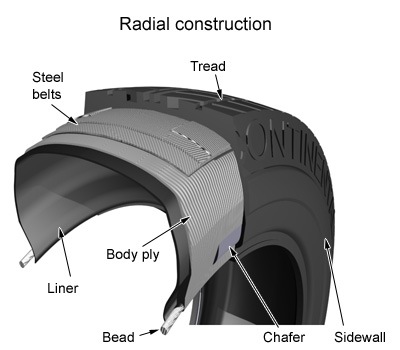
In amongst all this, there are three basic types of tread pattern that the manufacturers can choose to go with:
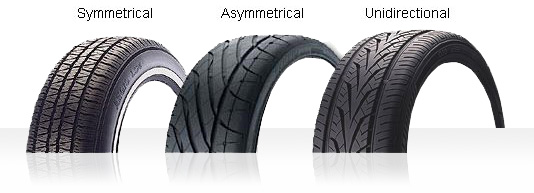 Symmetrical: consistent across the
tire's
face. Both halves of the treadface are the same design.
Symmetrical: consistent across the
tire's
face. Both halves of the treadface are the same design.
Asymmetrical: the tread pattern changes across the face of
the tire. These designs normally incorporates larger tread blocks on
the outer portion for increased stability during cornering. The
smaller inner blocks and greater use of grooves help to disperse
water and heat. Asymmetrical tires tend to also be
unidirectional tires.
Unidirectional: designed to rotate in only one direction,
these tires enhance straight-line acceleration by reducing rolling
resistance. They also provide shorter stopping distance.
Unidirectional tires must be dedicated to a specific side of the
vehicle, so the information on the sidewall will always include a
rotational direction arrow. Make sure the tires rotate in this
direction or you'll get into all sorts of trouble.
 |
 |
 |
| Return to our page on Automotive Articles | Return to Index Page | Email us now at thai4x4@gmail.com |
© 2002-2017 :: Sam Automotive Group :: All rights reserved ::
![]() thai4x4@gmail.com ::
thai4x4@gmail.com ::